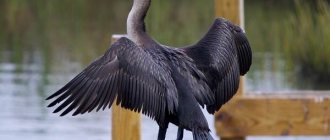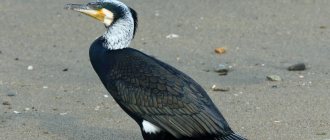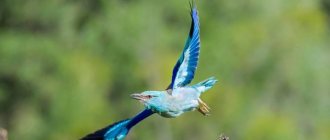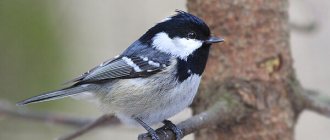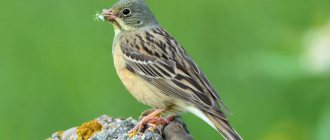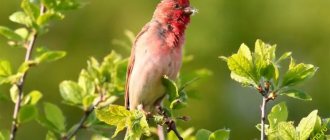What does a cormorant bird look like? Females differ from males in their size. Males have a larger body and can reach 100 centimeters. The wingspan reaches up to 150 centimeters. Feather color changes with age. Juveniles have brown plumage. As birds mature, their feathers darken, becoming black with a metallic sheen.
Some species have white spots on the head or abdomen. Some varieties are characterized by the presence of crests on the front of the head.
When hunting fish, the bird is helped by the presence of a thin long beak, reminiscent of a hook, and a long neck. When swallowing fish, it opens wide, which makes it easy to eat large specimens.
Their legs are large and webbed. The screams resemble hoarse croaks and moans. They swim very quickly in the water and maneuver well. On land they move slowly and clumsily.
Description and features
When it comes to the cormorant bird, the association “bird-fisher” immediately comes to mind for many! Indeed, we can say that cormorants rightfully deserve this unspoken nickname. They won it with dignity and confidence thanks to their colossal fishing skills.
The cormorant bird belongs to the cormorant family and belongs to seabirds. There are varieties of cormorants: crested, little black cormorant , great and many others.
In Latin the name of the bird is written as "Phalacrocorax". The sizes of cormorants vary. Some are similar in size, for example, to the merganser from the duck family; others will be larger. In any case, the length of the birds' bodies varies approximately from half a meter to one.
Some fly quickly, in a straight path. If they have to take off from the water surface, they run up and accelerate. The wingspan of cormorants can reach over one and a half meters. On average, the indicators fit into frames from eighty to one hundred and sixty centimeters.
The appearance of the cormorant varies. In color, adult cormorants are mostly dark: black, black and white (with a predominance of black), brownish, etc. It can be difficult to distinguish a male cormorant from a female due to the fact that they look very similar. Anyone can verify this by looking at what the cormorant in the photo .
Ornithologists who study birds of this genus are well aware of the insufficiently expressed visual differences between female and male birds; in their work and research activities they often encounter real individuals. As you know, with visual examples, learning any material is easier!
The sea cormorant has a long, hooked beak without nostrils. The paws contain membranes. The cormorant lives preferably in marine areas, but can also live on lakes.
Male and female main differences
Firstly, the male and female cormorants are very different in size. Males can reach 100 cm in length and have a wingspan of up to 150 cm; females cannot boast of this.
Secondly, the female may differ from the male in color or the presence of additional elements in the plumage. Such differences are highly dependent on species. For example, in the crested species, only males have a crest on their heads.
The differences become stronger towards the beginning of the mating season. Males begin to turn a different color, their plumage becomes much brighter, more noticeable, and more attractive. Females almost never change color.
Types of cormorants
There are various genera of cormorants (including small cormorants), and birds are also classified by species. There are only about forty species. Among them are the Indian, crested cormorant, great, small spotted cormorant, Bering, Galapagos, eared cormorant and others. Let's look at some of them in more detail.
The Indian cormorant, for example, is one of the smallest cormorant species. Lives on the Indochina Peninsula, o. Sri Lanka; its home is also India, Pakistan, etc. It feeds on fish. To get food for itself, it skillfully and deftly dives, briskly pursuing prey right under water.
The adult Crested Cormorant is a medium-sized black bird, approximately seventy centimeters long, with a graceful, pointed beak about five to six centimeters in length. The crested cormorant is great at diving and swims expertly.
But it doesn't fly very well. The flight looks difficult and does not last long. Like other cormorants, it eats fish. It prefers to catch it near the bottom. So in the distant expanses of the sea, under which there are impressive layers of water and the bottom is “too low”, you will not find it.
The great cormorant (also known as Black Sea cormorant , as some call it, in connection with one of the bird’s habitats) happily settles down on rocky surfaces. Birds love to spend time together and often gather together in fairly large numbers.
Cormorants of this species like to hunt cooperatively, finding fish in the sea and then “driving” them to shallower areas. The parental behavior of birds is interesting: representatives of both sexes take care of incubating the eggs: both females and males!
It’s unusual to think that a “father cormorant” can sit in a nest for warming eggs instead of a “mother.” Nevertheless, this is what happens. One of the most unique representatives of the cormorant is the white-breasted cormorant . The plumage of the chest is light, white or grayish. The bird is called one of the rarest species of cormorants.
The adult Bering cormorant is a "metallic black" bird with a crest of longer feathers on its head. Lives in Kamchatka, Chukotka, North America and other places. It flies well, even over impressive distances (it goes to open sea waters to fish), but on land it looks clumsy.
The Galapagos cormorant is special among its kind. Unlike others, it does not fly due to its extremely short wings! It looks somewhat like a duck. Despite its “disadvantage” in terms of flying abilities, the Galapagos cormorant swims excellently.
Population and species status
The distribution of these birds across our Planet is very extensive, and the total number of these birds does not cause any concern among the scientific world. At least for the next hundred years, nothing and nothing threatens these birds. Despite this fact, there are species among cormorants that are on the verge of extinction. Little and crested cormorants are listed in the Red Book of Russia. These birds are so trusting that crows and seagulls, who are distinguished by their cunning, easily steal eggs, leaving the birds without offspring.
Volga Delta. Cormorants. Hunting for fish.
Lifestyle and habitat
The cormorant is a supporter of active life during the daytime. What is the daytime part of their life like? The cormorant bird most of its day near or on the water, searching for food for its family and itself.
They show agility in catching fish, which is not surprising, because otherwise the catch would be meager or there would be none at all. Nevertheless, it is impossible not to emphasize its speed and maneuverability in the expanses of water - the bird is truly worthy of admiration.
Some species of cormorants fly to warmer climes for the winter; these are the majority. A smaller part remains in their native latitudes and leads a sedentary lifestyle. Some birds combine both characteristics, being both sedentary and partly migratory. For example, the red-faced cormorant.
Speaking about the characteristics of cormorants, I would like to emphasize again that they are quite sociable birds. They like to settle and set up nesting sites in large “groups”. Sometimes such a “society on the rock” includes only representatives of the cormorants themselves. At other times, there are also other birds present there, for example, seagulls, without which it is probably difficult to imagine any coastline.
It is interesting that the image of a cormorant appeared on various objects of art, culture, etc., for example, postage stamps, postcards, envelopes. Clothes with the image of a cormorant look impressive and unusual: T-shirts, dresses, etc.
Spreading
To accurately say about the prevalence of birds, it is necessary to clearly define what a cormorant is. Science says that the cormorant is a genus of seabird that belongs to the pelican order. In other words, every cormorant is a pelican, but not every pelican can be called a cormorant.
An important caveat, because in everyday life this bird is often understood exclusively as a great cormorant. Eating about 400 grams of fish per day, without encountering natural enemies that could regulate the number of birds, the bird is constantly increasing its own numbers and settling in new territories.
It gets to the point that insolent birds gather in tens and hundreds of thousands in especially attractive places, where they methodically exterminate fish. People have to act as a natural regulator and reduce the number of birds.
If the reader has already seen what a cormorant looks like, a photo of the bird can be seen alive. In Russia, the largest number of feathered friends is found in the Volga delta in the Astrakhan Nature Reserve.
However, the great cormorant is not only found here. It can be found wherever there is sea and rocks. Birds often fly even deep into the continent, settling in inland waters.
To do this, the great cormorant had to adapt to placing nests on tree branches, partially change its diet and change its species. Cormorant evolution cannot be reversed and we may be on the verge of an explosive increase in species diversity.
Some ornithologists say that there are many unoccupied ecological niches in the interior of the continents. At least some of them may be occupied by the cormorant or the bird that the described species will become after many generations. However, so far only a small number of cormorants have managed to penetrate deep into the continent.
An unusual way to use cormorants
The bird is a proud beast. Birds must fly, and life in cages is like death for them. It’s even more incredible if someone suddenly puts the bird on a leash. An absurd idea was implemented in Burma.
Local residents discovered that the cormorant is an ideal fisherman. While the bird lives in the wild, it uses its talent for personal food and helping its young. Why not put him on a leash and use him as a live fishing rod?
The practice of fishing with cormorants turned out to be so successful that Burma was able to abandon some of the fishing rods and thus optimize some of the costs.
However, if you order delivery of a live cormorant as an official fisherman, remember the following:
- Difficulties in catching fish. The reader already knows what cormorants eat. It is unlikely that birds will want to voluntarily share their prey with people who have put their feathered friend on a leash. You can tickle the cormorant's beak. Then the mouth will open and the fish will immediately fall out. The problem is that the cormorant may not like it if someone wants to tickle it. Then the bird will defend itself, and it knows how to defend itself well.
- Difficulties in controlling a cormorant. Nevertheless, the freedom-loving bird strives not only to catch a fish, but also to fly away to freedom. That's what the cormorant is in Burma - a live rod that is difficult to control, but exhibits the highest efficiency in catching fish! It's sad to lose a regular fishing rod. A hundred times worse - a live cormorant.
If this does not dissuade the reader from the idea of having a home fisherman, be prepared for the fact that after catching fish, the bird will be forced to dry its wings, spreading them wide. Are you sure you're ready for this?
Nutrition
A little about the nutrition of cormorants was discussed above, let’s look at the issue in more detail. The main “component” of the daily diet is, of course, medium-sized and also small-sized fish. Birds of this family welcome sardines, herring, and do not refuse capelin and others.
Despite the fact that cormorants feed on fish, it is not the only type of food for the family. They can eat crustaceans, starfish, etc. Some even eat frogs and snakes, turtles, and insects.
But let's get back to the fish. After fishing, which, as is known, is carried out by vigorously diving under water, cormorants have to spend some time on land: the shore, rocks or stones, so that their wings can dry.
The cormorant can often be seen in exactly this position, this is how the bird dries its feathers
Looking at bird nutrition more specifically, the following can be noted. Great cormorant , for example, dives for fish no deeper than four meters. The flight distance to which it “dares” to get food in the sea does not exceed on average fifty kilometers when viewed from land.
The fish that large cormorants usually choose are about a couple of tens of centimeters in length. Birds hunt while afloat, initially positioning themselves on the surface of the water and carefully concentrating on the search. Then they make a sharp jerk down. They hit the fish sharply on the side, grab it with the beak, and then remove it from the water.
The crested cormorant , by comparison, can dive much deeper for the desired prey than the great one! The crested cormorant (also called the long-nosed cormorant) can dive forty meters or even more.
It eats gobies, cod, eels, herring, etc., depending on its habitat. Apart from fish, he doesn’t particularly like anything, except that, as an exception, he may pay attention to a crustacean or mollusk.
Eared cormorants are precisely those who, if something happens, will not mind profiting from amphibians or crustaceans. They may eat insects. However, the preferred type of food for them, of course, remains fish. To obtain food, they choose shallower water areas, up to eight meters deep. They don’t want to go further than five kilometers deep into the sea.
Professional fisherman's body
If the reader wants to see what a cormorant bird looks like, the photo provides an excellent opportunity to appreciate the beauty of the animal. Let's take a closer look at the flying hunters.
The observer will probably notice:
- A long beak equipped with a sharp hook that is convenient for catching fish. The beak is used simultaneously as a harpoon and tweezers. With such an attack, the victim has no chance of survival.
- Webbed feet. Cormorants are not the only birds that swim. Take, for example, the well-known penguin, which spends almost half its life in the water, obtaining food for its offspring. But it is the cormorant that combines the ability to fly quickly and swim. True, the bird does not swim for very long, but there is enough time to catch and carry away the fish.
Long neck. Look at the cormorant photo. The bird easily turns its neck, quickly reacting to changes in the situation and catches prey with lightning speed.
Reproduction
Cormorants are thoroughly preparing to replenish their family. Nests are carefully prepared, which are made from twigs, etc. cormorant nest is usually located on the branches of a tree, but sometimes they can be found in reeds and other places.
Chicks mature and grow in eggs on average for twenty to thirty days. Considering that the female cormorant does not lay all the eggs at once, but one at a time, it is easy to understand why the hatched, “newly arrived” birds, being equally smooth, without feathers, and defenseless, are so different in size!
Speaking about the reproduction of cormorants more specifically, let us give an example with the Indian cormorant. This bird usually lays three, four or more eggs (the number can reach up to six). The chicks are born naked, without feathers. Later, fluff grows on them, then feathers appear.
The Bering cormorant chooses protective, secluded places for nesting, such as crevices and cracks in rocks, and others. The nests are large and spacious. As a rule, it lays three or four eggs, but there are other, less common cases when there may be a different number of eggs in the clutch: less, more.
As in the case of the Indian species of cormorant, the offspring are born completely devoid of any plumage, even down. Only after some time do the babies acquire their first “clothes” of gray color.
Where can you find an individual
Where do cormorants live?
The cormorant's habitat is so wide that it includes almost all latitudes of the planet. The countries in whose natural areas birds can freely live are the following: Iceland, Russia, Canada, Kazakhstan, China, New Zealand, Japan, some European and African states. During its migrations, the cormorant is found even in the vastness of Greenland.
Cormorants are divided into marine and freshwater; migratory and sedentary, whose wings are not adapted to long-term loads. The most common types are:The cormorant does not have population problems: for example, in the European region there are more than a million of its representatives. In total, three million birds of this species are registered on the planet.
- Cormorant
- Indian cormorant,
- Bering cormorant,
- crested cormorant,
- Red-faced cormorant.
Lifespan
The lifespan of cormorants can vary. On average, in the wild, cormorants can live up to about eighteen years or a little more. At the same time, if we take a specific type of cormorant, for example, the eared cormorant, then in natural conditions it lives on average about six years.
Cormorant meat dish
After removing the feathers, skin, fat and entrails, only meat and bones remain, which must be boiled for 30 minutes. Next, drain the water. Reboiling for an additional hour will remove some more of the stinky stuff that permeates the meat.
During the initial cooking there is an unpleasant fishy smell. Therefore, it would be more correct to first soak the carcass, divided into pieces, in slightly salted water. In addition to salt, you can add a little vinegar. Soak should be from one hour to five. After soaking in the marinade, you need to boil the meat for an hour or two. Drain this water.
Then add a small amount of water to the meat again. Add spices and mayonnaise. Simmer over low heat for 30 minutes. As you know, game always takes longer to cook than poultry.
An interesting custom involving the cormorant bird
Nowadays, some cormorants are known to live in zoos. This is one of the types of “communication” between a modern cormorant and a person. Previously, cormorants were also in “communication” with people. Only then the “interaction” looked different.
They say that in the old days there was such a custom as fishing with cormorants. This method has its roots in the distant past, its age is more than a thousand years. The method was used in countries such as China and Japan, as well as in European countries.
What was cormorant fishing like in general terms? The cormorant , known since ancient times for its fishing skills, caught fish not for itself, but for people! The man learned to “use” his skill to his advantage. It happened approximately as follows.
The bird was tamed over a period of time (about fourteen days on average). It should be noted that this process was very productive, the cormorants quickly got used to “their man,” and then “cooperation” began.
The bird was released onto the surface of the water, it began to hunt. After the dive, she swam up with the prey. But it was one thing to catch a fish, and another thing to make sure that the bird did not immediately eat the catch.
A method was invented for this: a special ring was put on the cormorant’s neck. The bird could move, fly, swim, of course, breathe and even drink. One thing: the bird could not eat. The caught fish did not pass through the “ringed throat”. But what was so difficult about chewing the prey and swallowing it piece by piece? – The answer is simple: cormorants don’t do that, they eat whole fish.
However, from time to time the birds received “their share”, since they could still swallow small fish. Plus, to encourage and maintain the “fighting spirit” of their feathered comrades, the fishermen also gave the birds small fish, thus fulfilling their “part of cooperation.”
A little about the behavior of cormorants
Remember the fishermen among people. Almost everyone goes to the river in the company of other connoisseurs of this activity. Fishing turns not so much into a way of obtaining food, but into social interaction, a kind of ritual.
The cormorant is a fully social fisherman. There are practically no representatives of the genus that hunt alone. Cormorants maintain contact with each other over long distances. Almost like people.
What are the birds talking about? Ornithologists don't know yet. It is difficult to understand the cormorant language, and even more difficult to understand their thoughts. Today, one thing is clear: birds are able to transmit information about the location of fish to their relatives. Ornithologists note the amazing mutual assistance inherent in these birds. Other experts say: science does not know the vicissitudes of the bird's soul and cannot understand the true motives of what is happening.
Perhaps the real reasons for what is happening are hidden in something else. However, the reader can see for himself what the cormorant bird looks like. The photo gives a complete picture of its appearance. By the appearance of animals one can predict their inner world. Although a number of cormorants look scary, the characteristic is a plus for them. Ethologists (specialists in the study of instincts) know: the stronger a predator’s weapons, the stronger its internal morality.
Cormorants in slang
Previously, inexperienced thieves were called cormorants, but now the word has moved from the narrow “thieves’” theme into a wider sphere of use, beginning to mean a narrow-minded, awkward person. The one who is not responsible for his words, the one who has the wind in his head, only chatter on his mind. In a word, someone rather “empty” and stupid.
In contrast to this negative image, a real cormorant , which is a bird, on the contrary, as is already clear from the above, is distinguished by its special intelligence and dexterity. The cormorant bird family is diverse, and each species has something of its own, individual. A distinctive feature, characteristic, skill - in a word, something that makes him unique in his own way.
The list of species and names could go on for a long time; studying this “section” of ornithology is fascinating and informative. One can only be amazed at how amazing the surrounding nature is, the living world created in all its diversity and, at the same time, uniqueness.
General provisions
The description of the cormorant bird should begin with the fact that, like all varieties of aquatic birds, this representative has webbed feet. This structure of the limbs allows it to move energetically through the water, looking for places where fish accumulate.
The cormorant can dive to a depth of fifteen meters. Nests on coastal trees or cliffs. It can also make a nest on a flat surface or a small island of land.
Range, habitats
If we talk about which country is the homeland or main refuge for cormorants, it is difficult to answer this question. They inhabit almost the entire globe, including they can be found on the territory of the Russian Federation. Sea coasts do not frighten cormorants either with scorching heat or piercing cold. Our country is currently home to as many as six species, among which the Great Cormorant is considered the most common.
This is interesting! The bird is also distributed throughout Australia, with the exception of wet coastal mangroves and tropical forests. Also inhabits the Lesser Sunda Islands.
Return to content
WHAT DOES IT EAT?
Great cormorants are one of the most common birds on the sea coasts. These birds are found in fresh, brackish and sea waters. Cormorants hunt mainly on coastal shallows. They feed on various types of fish and are excellent at hunting them. The cormorant dives from the surface of the water or jumps from a stone or branch completely silently, without raising waves. Underwater it moves rapidly, uses its wide tail as an oar and, strongly raking with its paws, swims forward. The paws of cormorants have strong thigh muscles, each with 4 forward-pointing toes, connected by a swimming membrane. Thus, the surface of the paw has a large area and helps to stay afloat. This rear-mounted “motor” works very efficiently, and the bird swims very quickly. Cormorants can remain underwater for 60 seconds and rise to the surface at a distance of several meters from the place where they dived. When potential prey appears nearby, the cormorant rushes after it and grabs it with its sharp beak. With the prey, the bird emerges to the surface, where it conveniently places it in its beak and swallows it whole. It hunts different types of fish: flounder, cod, herring and eels, which it can track at a depth of up to 10 m.
Natural enemies
For large adult cormorants, other animals do not pose a danger . However, their small, defenseless chicks often become victims of coyotes, raccoons and foxes. The worst enemies of the cormorant are considered to be crows, which try to steal eggs from the nest; sometimes seagulls and starlings try to get into the cormorant’s “home” for the same purpose.
Return to content
Roast for everyone
No matter how hard you try to remove the smell and taste of fish from the trophy, some bad-smelling compounds will still remain in it. Therefore, the dishes still turn out to be specific. However, if a person is not too spoiled, then he will like game. It is especially pleasant to cook cormorant in nature, where the air itself gives the appetite. A cormorant in a bowler hat carries the spirit of adventure.
Lifestyle
Cormorants are active during the day. Many representatives are migratory. During nesting, they settle in large groups, often in the vicinity of terns, gulls, and penguins. Sedentary species begin to look for a mate in May. Migratory cormorants arrive at the nesting site with a partner.
The bird's nest looks simple. It is made from leaves and branches, placed on the tops of trees or in coastal rocks. The female lays one egg every few days, there are up to six of them in total. The chicks are born helpless; their parents feed them for several months, and sometimes until they reach adulthood.
Cormorants reach maturity after 2-4 years. They are born completely naked, acquiring feathers only after 30-80 days. Many species have several “outfits.” For example, great cormorants have a first breeding color, a second color, and then an adult color.
